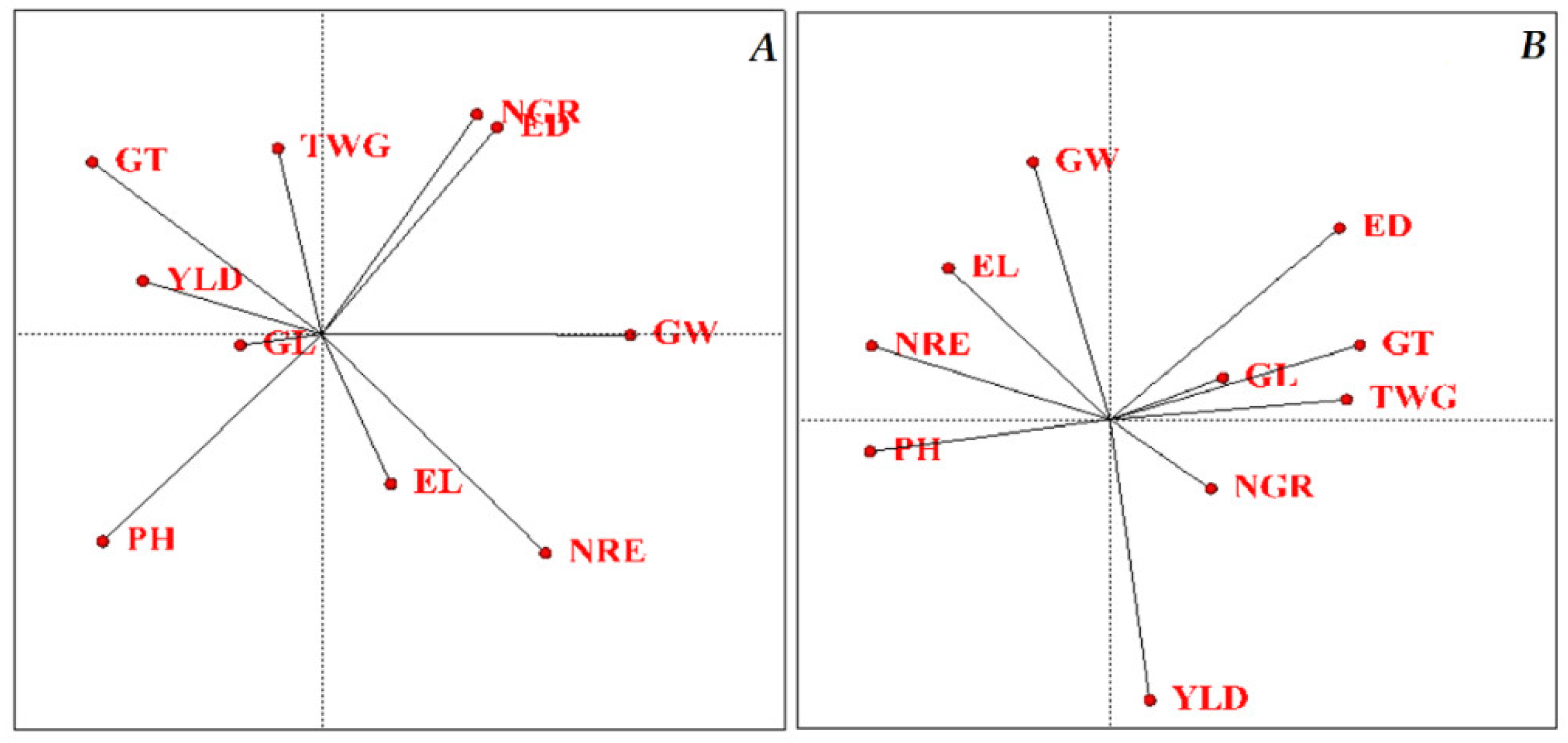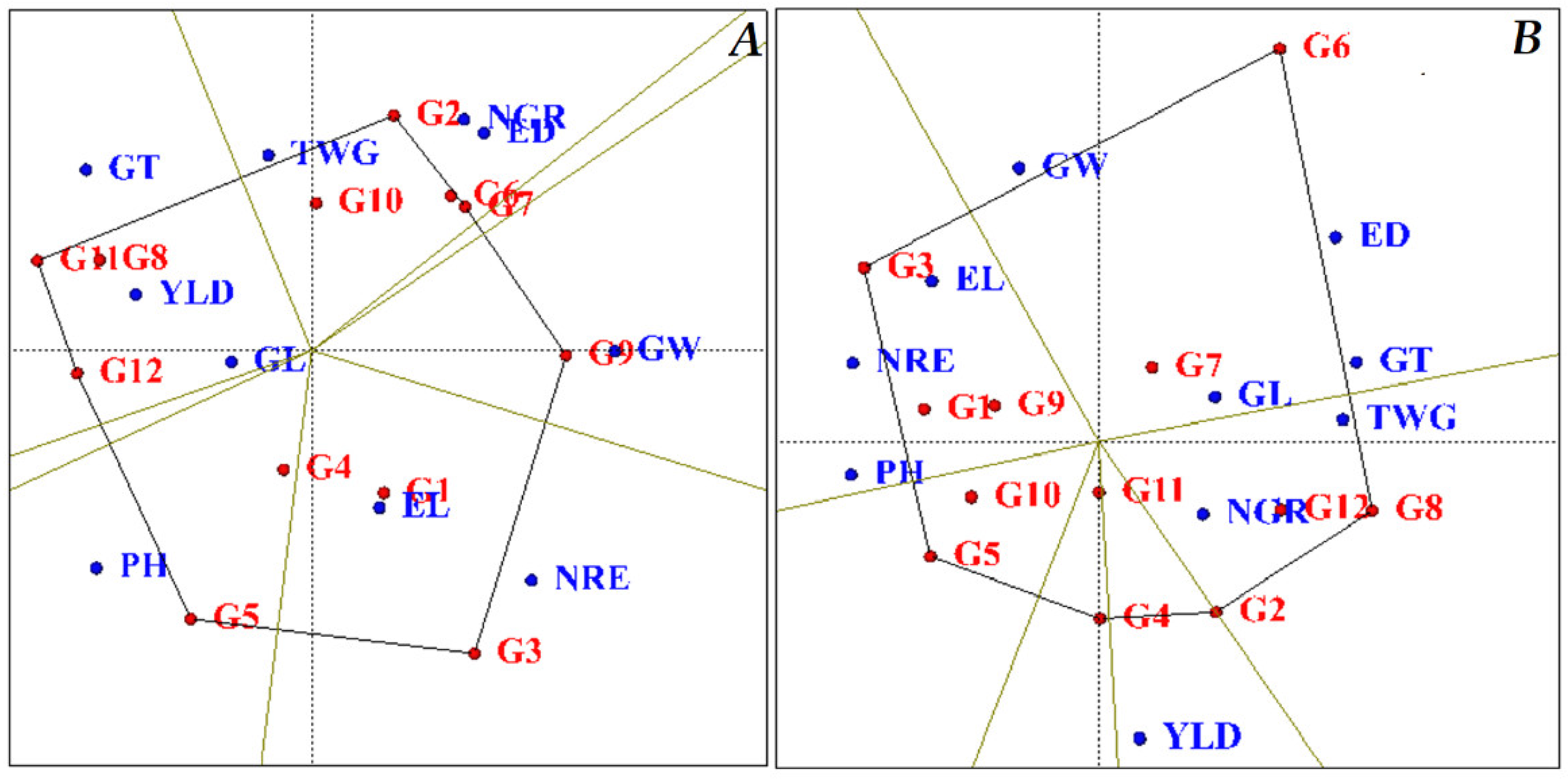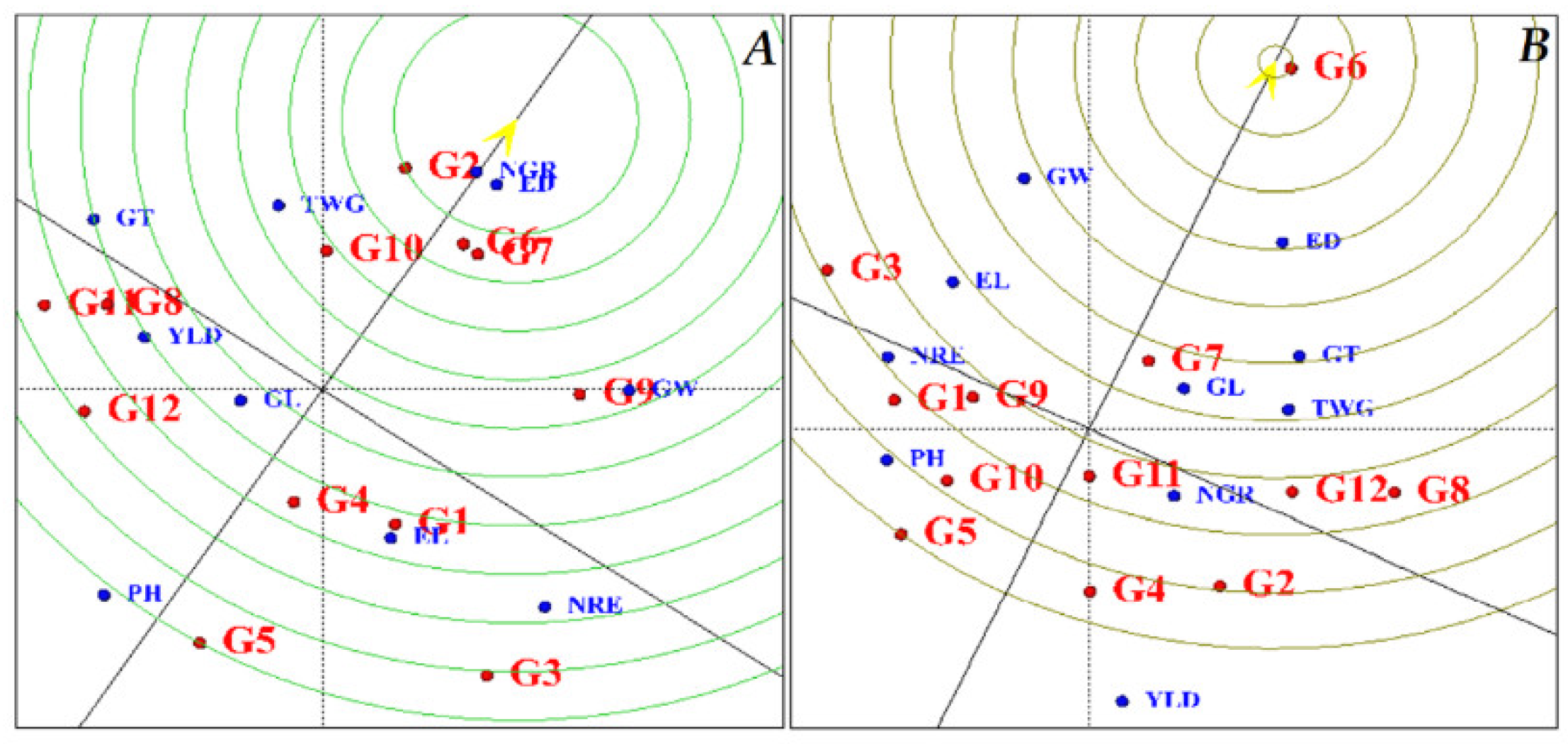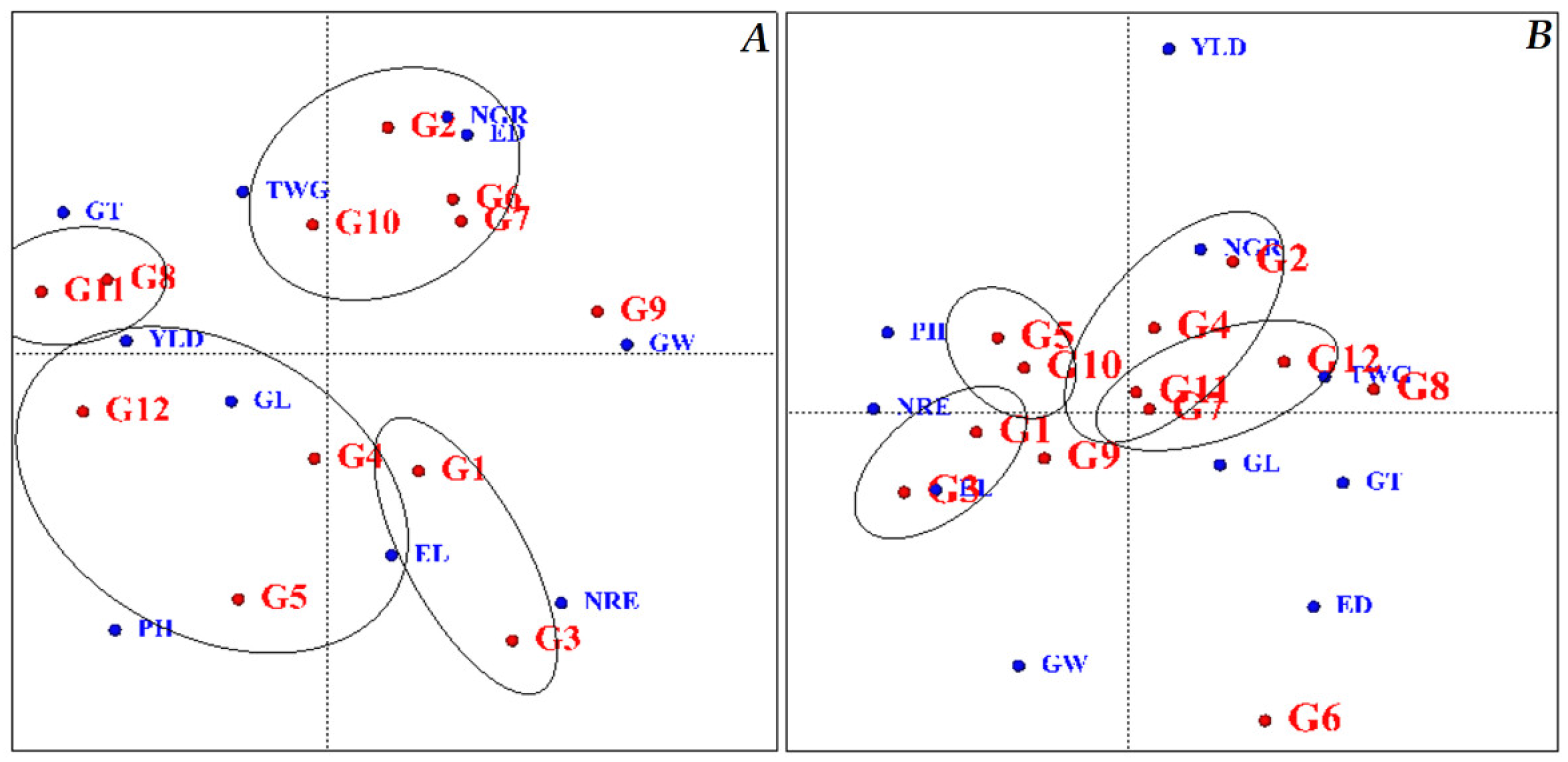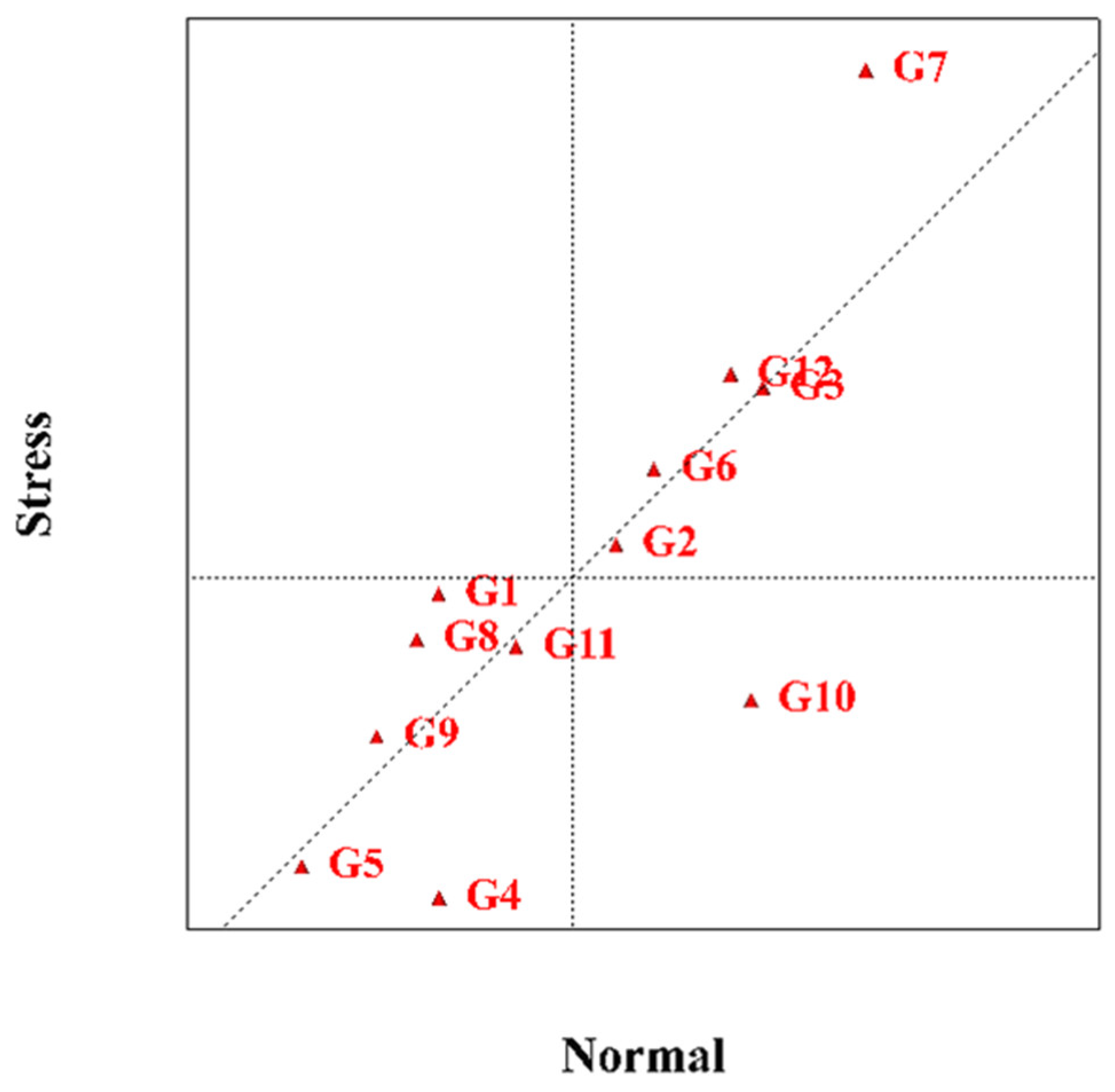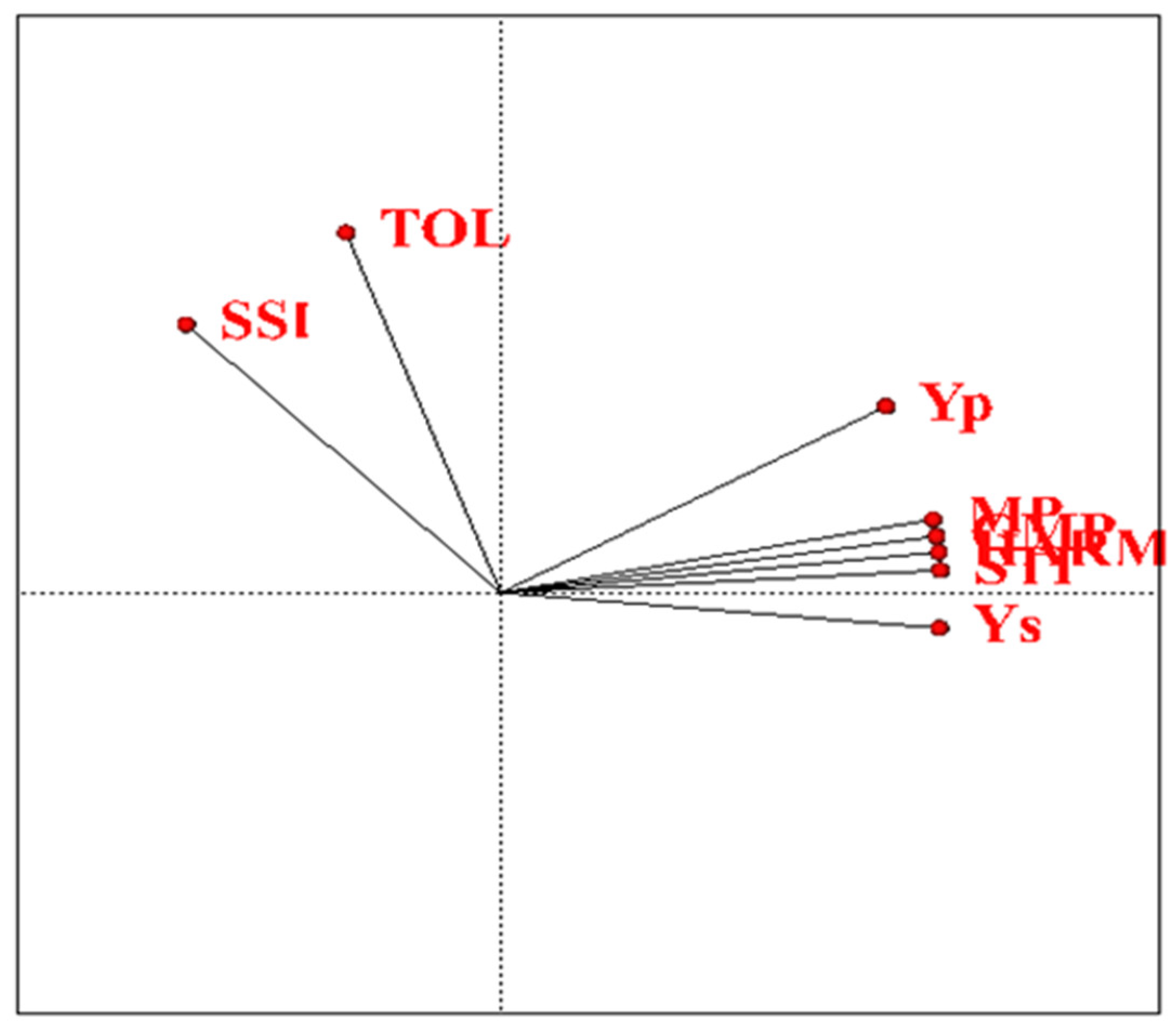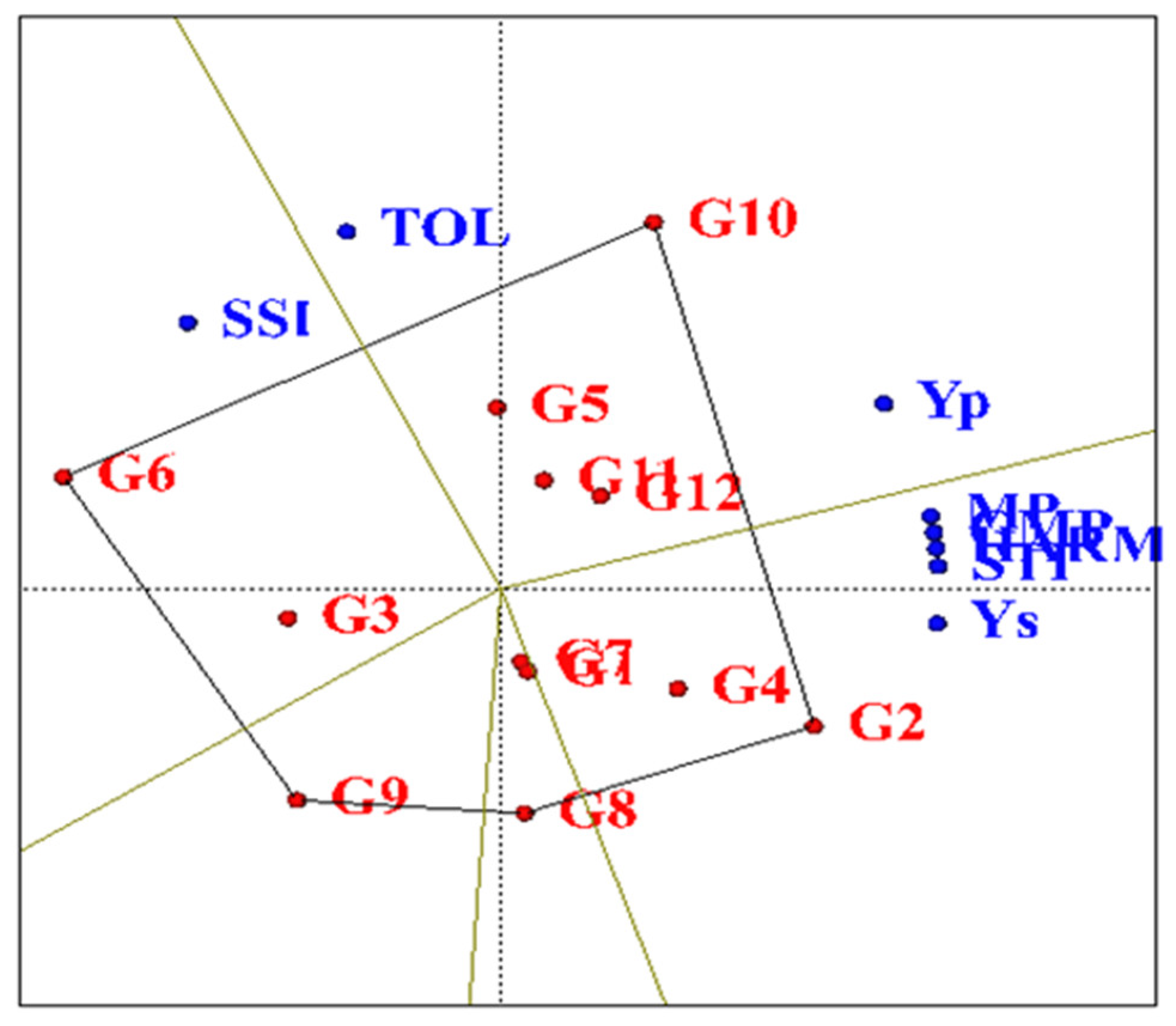Figure 1.
Correlation diagram between the studied traits under normal conditions and water stress. (A): normal conditions; (B): stress conditions. PH: Plant height, EL: Ear length, ED: Ear diameter, NGR: Number of grains in a row, NRE: Number of rows in-ear, GW: Grain weight, GL: Grain Length, GT: Grain Thickness, TWG: Thousand-grain weight, and YLD: Grain yield.
Figure 1.
Correlation diagram between the studied traits under normal conditions and water stress. (A): normal conditions; (B): stress conditions. PH: Plant height, EL: Ear length, ED: Ear diameter, NGR: Number of grains in a row, NRE: Number of rows in-ear, GW: Grain weight, GL: Grain Length, GT: Grain Thickness, TWG: Thousand-grain weight, and YLD: Grain yield.
Figure 2.
Ranking and Grouping of Genotypes in Terms of Traits. (A): normal conditions; (B): stress conditions. PH: Plant height, EL: Ear length, ED: Ear diameter, NGR: Number of grains in a row, NRE: Number of rows in-ear, GW: Grain weight, GL: Grain Length, GT: Grain Thickness, TWG: Thousand-grain weight, and YLD: Grain yield. G1: KSC703, G2: KSC260, G3: KSC705, G4: KSC400, G5: KSC706, G6: KSC704, G7: KSC707, G8: DC370, G9: SC647, G10: SC302, G11: SC604, and G12: SC301.
Figure 2.
Ranking and Grouping of Genotypes in Terms of Traits. (A): normal conditions; (B): stress conditions. PH: Plant height, EL: Ear length, ED: Ear diameter, NGR: Number of grains in a row, NRE: Number of rows in-ear, GW: Grain weight, GL: Grain Length, GT: Grain Thickness, TWG: Thousand-grain weight, and YLD: Grain yield. G1: KSC703, G2: KSC260, G3: KSC705, G4: KSC400, G5: KSC706, G6: KSC704, G7: KSC707, G8: DC370, G9: SC647, G10: SC302, G11: SC604, and G12: SC301.
Figure 3.
Diagram of the reaction of maize hybrids based on the ideal genotype under normal conditions and water stress. (A): normal conditions, (B): stress conditions. PH: Plant height, EL: Ear length, ED: Ear diameter, NGR: Number of grains in a row, NRE: Number of rows in-ear, GW: Grain weight, GL: Grain Length, GT: Grain Thickness, TWG: Thousand-grain weight, and YLD: Grain yield. G1: KSC703, G2: KSC260, G3: KSC705, G4: KSC400, G5: KSC706, G6: KSC704, G7: KSC707, G8: DC370, G9: SC647, G10: SC302, G11: SC604, and G12: SC301.
Figure 3.
Diagram of the reaction of maize hybrids based on the ideal genotype under normal conditions and water stress. (A): normal conditions, (B): stress conditions. PH: Plant height, EL: Ear length, ED: Ear diameter, NGR: Number of grains in a row, NRE: Number of rows in-ear, GW: Grain weight, GL: Grain Length, GT: Grain Thickness, TWG: Thousand-grain weight, and YLD: Grain yield. G1: KSC703, G2: KSC260, G3: KSC705, G4: KSC400, G5: KSC706, G6: KSC704, G7: KSC707, G8: DC370, G9: SC647, G10: SC302, G11: SC604, and G12: SC301.
Figure 4.
Graphing diagram of Maize hybrids based on the traits studied in the experiment under normal conditions and moisture stress. (A): normal conditions, (B): stress conditions. PH: Plant height, EL: Ear length, ED: Ear diameter, NGR: Number of grains in a row, NRE: Number of rows in-ear, GW: Grain weight, GL: Grain Length, GT: Grain Thick-ness, TWG: Thousand-grain weight, and YLD: Grain yield. G1: KSC703, G2: KSC260, G3: KSC705, G4: KSC400, G5: KSC706, G6: KSC704, G7: KSC707, G8: DC370, G9: SC647, G10: SC302, G11: SC604, and G12: SC301.
Figure 4.
Graphing diagram of Maize hybrids based on the traits studied in the experiment under normal conditions and moisture stress. (A): normal conditions, (B): stress conditions. PH: Plant height, EL: Ear length, ED: Ear diameter, NGR: Number of grains in a row, NRE: Number of rows in-ear, GW: Grain weight, GL: Grain Length, GT: Grain Thick-ness, TWG: Thousand-grain weight, and YLD: Grain yield. G1: KSC703, G2: KSC260, G3: KSC705, G4: KSC400, G5: KSC706, G6: KSC704, G7: KSC707, G8: DC370, G9: SC647, G10: SC302, G11: SC604, and G12: SC301.
Figure 5.
The Centred Scatter Plot Maize hybrids examined in experiments under normal conditions and humidity stress. G1: KSC703, G2: KSC260, G3: KSC705, G4: KSC400, G5: KSC706, G6: KSC704, G7: KSC707, G8: DC370, G9: SC647, G10: SC302, G11: SC604, and G12: SC301.
Figure 5.
The Centred Scatter Plot Maize hybrids examined in experiments under normal conditions and humidity stress. G1: KSC703, G2: KSC260, G3: KSC705, G4: KSC400, G5: KSC706, G6: KSC704, G7: KSC707, G8: DC370, G9: SC647, G10: SC302, G11: SC604, and G12: SC301.
Figure 6.
Correlation diagram between drought-tolerance indices studied under water stress conditions. Yp: Yield under normal condition, Ys: yield under drought condition, TOL: Tolerance, MP: Mean Productivity, GMP: Geometric Mean Productivity, HARM: Harmonic Mean Productivity, SSI: Stress Susceptibility Index, STI: Stress Tolerance Index.
Figure 6.
Correlation diagram between drought-tolerance indices studied under water stress conditions. Yp: Yield under normal condition, Ys: yield under drought condition, TOL: Tolerance, MP: Mean Productivity, GMP: Geometric Mean Productivity, HARM: Harmonic Mean Productivity, SSI: Stress Susceptibility Index, STI: Stress Tolerance Index.
Figure 7.
Diagram of a polygon diagram of the reaction of maize hybrids to drought-tolerance indices studied under water stress conditions. Yp: Yield under normal condition, Ys: yield under drought condition, TOL: Tolerance, MP: Mean Productivity, GMP: Geometric Mean Productivity, HARM: Harmonic Mean Productivity, SSI: Stress Susceptibility Index, STI: Stress Tolerance Index. G1: KSC703, G2: KSC260, G3: KSC705, G4: KSC400, G5: KSC706, G6: KSC704, G7: KSC707, G8: DC370, G9: SC647, G10: SC302, G11: SC604, and G12: SC301.
Figure 7.
Diagram of a polygon diagram of the reaction of maize hybrids to drought-tolerance indices studied under water stress conditions. Yp: Yield under normal condition, Ys: yield under drought condition, TOL: Tolerance, MP: Mean Productivity, GMP: Geometric Mean Productivity, HARM: Harmonic Mean Productivity, SSI: Stress Susceptibility Index, STI: Stress Tolerance Index. G1: KSC703, G2: KSC260, G3: KSC705, G4: KSC400, G5: KSC706, G6: KSC704, G7: KSC707, G8: DC370, G9: SC647, G10: SC302, G11: SC604, and G12: SC301.
Table 1.
Analysis of variance of studied hybrids in terms of traits under normal conditions and humidity stress.
Table 1.
Analysis of variance of studied hybrids in terms of traits under normal conditions and humidity stress.
| | MS |
|---|
| State | S.O.V. | DF | PH | EL | ED | NGR | NRE | GW | GL | GT | TWG | YLD |
|---|
| Normal Condition | Block | 2 | 110.1 ns | 0.06 * | 9.59 * | 4.68 * | 31.6 ns | 0.57 * | 1.31 ns | 1.27 ns | 277.6 ns | 0.21 ns |
| Genotype | 11 | 519.2 ns | 10.8 ** | 62.6 ** | 9.48 * | 73.79 ns | 2.91 ** | 5.95 ns | 2.21 ns | 3961.9 * | 0.77 * |
| Error | 22 | 331.9 | 1.69 | 14.47 | 3.56 | 53.3 | 0.75 | 4.8 | 1.87 | 3035.2 | 1.83 |
| CV% | --- | 9.91 | 7.8 | 9.28 | 11.46 | 19.3 | 15.81 | 22.8 | 30.16 | 18.9 | 18.87 |
| Stress Condition | Block | 2 | 577.6 ns | 0.36 ns | 10.08 ns | 1.33 ns | 17.33 ns | 0.13 ns | 8.14 * | 8.37 ns | 6385.08 * | 2.33 * |
| Genotype | 11 | 390.35 ns | 8.96 ** | 40.5 * | 6.5 ns | 68.2 * | 0.66 ns | 4.5 * | 1.45 ns | 2037.8 * | 0.91 * |
| Error | 22 | 832.3 | 2.55 | 19.93 | 3.87 | 35.39 | 0.73 | 2.63 | 1.29 | 2083.3 | 1.23 |
| CV% | --- | 22.5 | 13.19 | 17.38 | 15.54 | 21.5 | 23.03 | 22.4 | 28.8 | 23.9 | 20.72 |
Table 2.
Comparison of Duncan’s mean for traits in 12 hybrids of maize under normal conditions and humidity stress.
Table 2.
Comparison of Duncan’s mean for traits in 12 hybrids of maize under normal conditions and humidity stress.
| | Genotype | Rank | PH | EL | ED | NGR | NRE | GW | GL | GT | TWG | YLD |
|---|
| Normal Condition | KSC703 | 7 | 182ab | 17.7b | 38.4cde | 15.1bc | 39.1ab | 6.3ab | 9.4ab | 2.9bc | 258.4ab | 7.1abc |
| KSC260 | 5 | 162.4b | 17.1bc | 42.3abcd | 19.7a | 35.6ab | 5.5abc | 6.8b | 4.1ab | 316.6ab | 7.64ab |
| KSC705 | 6 | 197.8ab | 21.4a | 40.9bcd | 15.1bc | 48.6a | 5.9ab | 8.4ab | 2.7bc | 290.5ab | 6.65bc |
| KSC400 | 10 | 185.9ab | 14.8cd | 36.8de | 14.5c | 40.2ab | 5.6ab | 10.9ab | 2.6bc | 297.1ab | 7.4ab |
| KSC706 | 9 | 198.7a | 17.1bc | 32.5e | 14.6c | 40.8ab | 4.9bcd | 8.6ab | 3.7abc | 225.8ab | 7.4ab |
| KSC704 | 3 | 167.3ab | 16.8bcd | 49.4a | 16.7abc | 37.7ab | 5.8ab | 10.2ab | 4.3ab | 297.8ab | 6.35bcd |
| KSC707 | 1 | 171.9ab | 16.8bcd | 42.9abcd | 18.4ab | 38.1ab | 7.01a | 10ab | 3.6abc | 336.6a | 7.1abc |
| DC370 | 11 | 160.8ab | 14.4d | 38.4cde | 14.5c | 30.5b | 4.9bcd | 10.2ab | 4.6ab | 337.4a | 6.9bc |
| SC647 | 8 | 176.6ab | 14.4d | 44.3abc | 18.7ab | 40.5ab | 6.5ab | 9.8ab | 2.4c | 232.6ab | 6.42bcd |
| SC302 | 4 | 176.2ab | 15.6bcd | 46.2ab | 17abc | 36.3ab | 5.5abc | 9.17ab | 3.5abc | 310.5ab | 8a |
| SC604 | 12 | 202.7a | 16.1bcd | 41.8abc | 16.9abc | 29.9b | 3.6d | 8.5ab | 5.1a | 276.6ab | 7.4a |
| SC301 | 2 | 193.1ab | 17.6b | 37.5cde | 15.9bc | 35.2ab | 3.9cd | 12.4a | 4.2ab | 306ab | 7.5ab |
| Stress Condition | KSC703 | 5 | 137.3abc | 13.3ab | 22.8bc | 12b | 28abc | 4.26ab | 7.2abc | 1.76cd | 161.6cd | 5.45bc |
| KSC260 | 6 | 110de | 11.26bcd | 27.1abc | 16a | 27.3abc | 3.4bc | 5.48c | 2.28bcd | 195bc | 6.26a |
| KSC705 | 4 | 133bcd | 15.8a | 23.9bc | 12.6ab | 36.6a | 4.13ab | 7.2abc | 1.3d | 188.6bcd | 4.78cd |
| KSC400 | 12 | 121cde | 9.3d | 23.2bc | 12b | 26abc | 3.4bc | 8.9ab | 1.48cd | 166.6cd | 5.87ab |
| KSC706 | 11 | 136abc | 12.6bc | 20.4c | 11.3bc | 32.6ab | 3c | 6.06bc | 2.4bcd | 166.3cd | 5.29bc |
| KSC704 | 3 | 108.6e | 12.4bc | 34.2a | 11.3bc | 26.6abc | 4.5a | 7.8abc | 3.42a | 193.6bc | 4.14d |
| KSC707 | 1 | 134bc | 13.13ab | 25.5abc | 14.6ab | 31.3abc | 3.93bc | 7.03abc | 2.68bc | 228ab | 5.43bc |
| DC370 | 7 | 119.6de | 9.66cd | 29.2ab | 12.6ab | 20c | 3.3bc | 7.2abc | 2.93bc | 236a | 5.48bc |
| SC647 | 9 | 141.6a | 11.66bcd | 25.7bc | 13.3ab | 25.3abc | 4.13ab | 7.2abc | 1.65cd | 155.3d | 4.85cd |
| SC302 | 8 | 133.6bcd | 11.96bcd | 24.4bc | 11.3bc | 32ab | 3.66bc | 5.6c | 1.85bcd | 188cd | 5.66ab |
| SC604 | 10 | 140ab | 12.2bcd | 23.2bc | 11.3bc | 22.6bc | 3.5bc | 7.05abc | 2.95bc | 191.3bc | 5.44bc |
| SC301 | 2 | 121.6cd | 12.5bc | 24.8bc | 13.3ab | 23.3bc | 3.2bc | 9.7a | 3.09ab | 216.6ab | 5.6ab |
Table 3.
Correlation coefficients between the evaluated traits under normal conditions and water stress.
Table 3.
Correlation coefficients between the evaluated traits under normal conditions and water stress.
| Normal Condition | | PH | EL | ED | NGR | NRE | GW | GL | GT | TWG |
| EL | 0.14 ns | | | | | | | | |
| ED | −0.46 ** | −0.08 ns | | | | | | | |
| NGR | −0.39 * | −0.1 ns | 0.31 * | | | | | | |
| NRE | 0.08 ns | 0.2 ns | −0.15 ns | 0.07 * | | | | | |
| GW | −0.34 * | −0.1 ns | 0.22 * | 0.33 ns | 0.4 * | | | | |
| GL | 0.22 ns | 0.01 * | −0.14 ns | 0.003 ns | −0.04 * | 0.03 ns | | | |
| GT | 0.28 ns | −0.06 * | 0.05 ns | 0.04 * | −0.39 * | 0.31 * | 0.03 ns | | |
| TWG | 0.13 ns | −0.12 ns | 0.008 ns | −0.11 * | 0.004 ns | 0.01 ns | 0.1 ns | 0.41 * | |
| YLD | 0.18 ns | 0.08 ns | −0.19 * | 0.07 ns | −0.003 ns | 0.14 ns | 0.1 * | 0.26 ns | 0.46 ** |
| Stress Condition | EL | 0.2 * | | | | | | | | |
| ED | −0.12 ns | 0.26 * | | | | | | | |
| NGR | −0.14 ns | 0.06 * | 0.09 ns | | | | | | |
| NRE | 0.06 ns | 0.51 ** | −0.31 * | 0.08 ns | | | | | |
| GW | 0.07 ns | 0.15 ns | 0.03 * | 0.19 * | 0.23 ns | | | | |
| GL | 0.53 * | −0.02 ns | −0.16 ns | 0.13 ns | −0.06 ns | 0.12 * | | | |
| GT | 0.02 ns | 0.04 ns | 0.35 * | 0.09 ns | 0.29 * | 0.14 ns | −0.02 * | | |
| TWG | 0.1 * | 0.07 ns | 0.01 * | 0.05 ns | −0.004 ns | −0.16 * | 0.21 * | 0.41 * | |
| YLD | −0.06 ns | 0.04 ns | 0.25 * | 0.14 ns | 0.006 ns | 0.1 * | −0.03 ns | 0.17 ns | 0.29 * |
Table 4.
Evaluation of hybrids evaluated in the test under stress conditions through drought-tolerance indices.
Table 4.
Evaluation of hybrids evaluated in the test under stress conditions through drought-tolerance indices.
| Genotypes | Yp | R | Ys | R | TOL | R | MP | R | HARM | R | GMP | R | SSI | R | STI | R |
|---|
| KSC703 | 7.1 | 8 | 5.45 | 6 | 1.65 | 5 | 6.275 | 7 | 6.166 | 7 | 6.22 | 7 | 0.92 | 4 | 14.5 | 6 |
| KSC260 | 7.64 | 6 | 6.26 | 1 | 1.38 | 1 | 6.95 | 1 | 6.881 | 1 | 6.91 | 1 | 0.71 | 1 | 17.3 | 1 |
| KSC705 | 6.65 | 10 | 4.78 | 11 | 1.87 | 7 | 5.715 | 10 | 5.562 | 10 | 5.63 | 10 | 1.11 | 9 | 12.3 | 10 |
| KSC400 | 7.4 | 5 | 5.87 | 2 | 1.53 | 3 | 6.635 | 3 | 6.546 | 3 | 6.59 | 3 | 0.82 | 3 | 15.9 | 3 |
| KSC706 | 7.4 | 4 | 5.29 | 9 | 2.11 | 10 | 6.345 | 6 | 6.169 | 6 | 6.25 | 6 | 1.13 | 10 | 14.3 | 8 |
| KSC704 | 6.35 | 12 | 4.14 | 12 | 2.21 | 11 | 5.245 | 12 | 5.012 | 12 | 5.12 | 12 | 1.38 | 11 | 10.4 | 12 |
| KSC707 | 7.1 | 7 | 5.43 | 8 | 1.67 | 6 | 6.265 | 8 | 6.153 | 8 | 6.2 | 8 | 0.93 | 5 | 14.4 | 7 |
| DC370 | 6.9 | 9 | 5.48 | 5 | 1.42 | 2 | 6.19 | 9 | 6.108 | 9 | 6.14 | 9 | 0.81 | 2 | 14.3 | 9 |
| SC647 | 6.42 | 11 | 4.85 | 10 | 1.57 | 4 | 5.635 | 11 | 5.525 | 11 | 5.58 | 11 | 0.97 | 6 | 12.2 | 11 |
| SC302 | 8 | 1 | 5.66 | 3 | 2.34 | 12 | 6.83 | 2 | 6.629 | 2 | 6.72 | 2 | 1.6 | 12 | 16 | 2 |
| SC604 | 7.4 | 3 | 5.44 | 7 | 1.96 | 9 | 6.42 | 5 | 6.270 | 5 | 6.34 | 5 | 1.05 | 8 | 14.7 | 5 |
| SC301 | 7.5 | 2 | 5.6 | 4 | 1.9 | 8 | 6.55 | 4 | 6.41 | 4 | 6.48 | 4 | 1 | 7 | 15.3 | 4 |
Table 5.
Selected hybrids based on drought-tolerance indices.
Table 5.
Selected hybrids based on drought-tolerance indices.
| Index | Selected Hybrids |
|---|
| Based on Yp | SC604, SC301, SC302 |
| Based on Ys | SC302, KSC400, KSC260 |
| Based on TOL | KSC400, DC370, KSC260 |
| Based on MP | KSC400, SC302, KSC260 |
| Based on HARM | KSC400, SC302, KSC260 |
| Based on GMP | KSC400, SC302, KSC260 |
| Based on SSI | KSC400, DC370, KSC260 |
| Based on STI | KSC400, SC302, KSC260 |
Table 6.
Correlation coefficients between drought-tolerance indices evaluated under water stress conditions.
Table 6.
Correlation coefficients between drought-tolerance indices evaluated under water stress conditions.
| | Yp | Ys | TOL | MP | Harm | GMP | SSI |
|---|
| Ys | −0.15 ns | | | | | | |
| TOL | 0.95 ** | 0.44 ns | | | | | |
| MP | 0.97 ** | 0.36 ns | 0.99 ** | | | | |
| Harm | 0.96 ** | 0.4 ns | 0.99 ** | 0.98 ** | | | |
| GMP | −0.35 ns | 0.87 * | −0.05 ns | −0.13 ns | −0.09 ns | | |
| SSI | 0.98 ** | 0.33 ns | 0.98 ** | 0.9 ** | 0.9 ** | −0.18 ns | |
| STI | −0.36 ns | −0.67 ns | −0.53 ns | −0.49 ns | −0.51 ns | −0.45 ns | −0.46 ns |
Table 7.
Principal components analysis for average grain yield under normal conditions and moisture stress and drought-tolerance indices.
Table 7.
Principal components analysis for average grain yield under normal conditions and moisture stress and drought-tolerance indices.
| | % Variance | % Cumulative Variance | Yp | Ys | TOL | MP | Harm | GMP | SSI | STI |
|---|
| Factor 1 | 0.789 | 0.789 | 0.348 | 0.396 | −0.13 | 0.39 | 0.395 | 0.393 | −0.28 | 0.397 |
| Factor 2 | 0.209 | 0.999 | 0.374 | −0.07 | 0.722 | 0.147 | 0.081 | 0.113 | 0.538 | 0.045 |
Table 8.
Name and code of hybrids, traits and drought-tolerance indices studied in the experiment.
Table 8.
Name and code of hybrids, traits and drought-tolerance indices studied in the experiment.
| Genotype No. | Genotype | Traits Code | Traits | Indices Code | Indices |
|---|
| G1 | KSC 703 | PH | Plant height | Yp | Yield under normal condition |
| G2 | KSC 260 | EL | Ear length | Ys | Yield under drought condition |
| G3 | KSC 705 | ED | Ear diameter | TOL | Tolerance |
| G4 | KSC 400 | NGR | Number of grains in row | MP | Mean Productivity |
| G5 | KSC 706 | NRE | Number of rows in ear | GMP | Geometric Mean Productivity |
| G6 | KSC 704 | GW | Grain weight | HARM | Harmonic Mean Productivity |
| G7 | KSC 707 | GL | Grain Length | SSI | Stress Susceptibility Index |
| G8 | DC 370 | GT | Grain Thickness | STI | Stress Tolerance Index |
| G9 | SC 647 | TWG | Thousand grain weight | | |
| G10 | SC 302 | YLD | Grain yield | | |
| G11 | SC 604 | | | | |
| G12 | SC 301 | | | | |
Table 9.
Soil characteristics of the cultivated area in the experiment.
Table 9.
Soil characteristics of the cultivated area in the experiment.
| Region | EC (ds/m) | Acidity | Lime (%) | Organic Carbon (%) | Organic Materials (%) | Clay (%) | Silt (%) | Sand (%) |
|---|
| Karaj | 0.20 | 8.2 | 7 | 32 | 45 | 32 | 25 | 22 |
